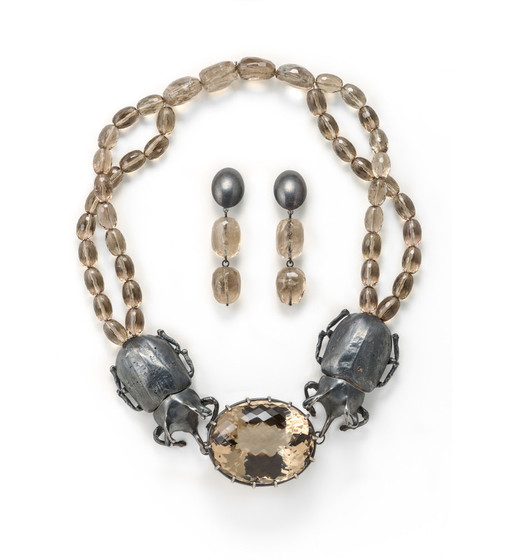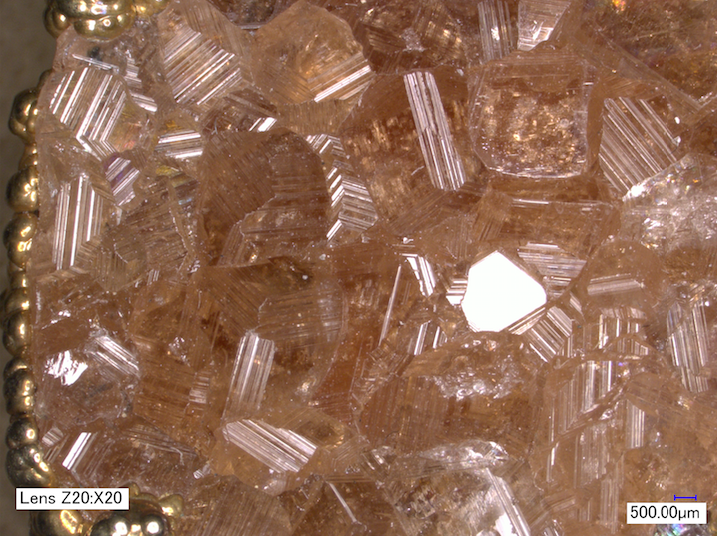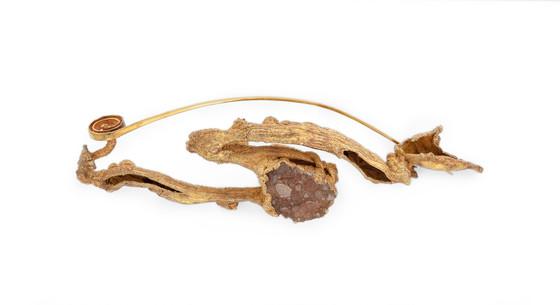As a Mellon Fellow of the Conservation Research Laboratory, I work on different projects to answer questions that curators and conservators have about the art objects they are working on. The Lois Boardman Jewelry project was unique for multiple reasons: the number of objects in the collection that needed analysis (more than 300 contemporary jewelry pieces), the diversity of the materials used (plastics, metals, fabrics, and more), and the opportunity to compare our results to surveys that the decorative arts and design curatorial department had sent out to the artists. The survey was created to help collect information for each piece; the artists described the techniques and the materials employed. Interestingly, in some cases, during the scientific examination of the objects, we found some discrepancies between our results and the artist survey.
Of all the objects that we analyzed for the project, I found the ones with gemstones the most interesting because the identification of the stones was the most challenging. Any analysis we performed had to be non-invasive (no damage to the piece); we performed elementals analysis (X-Ray Fluorescence spectroscopy) and chemical bonds analysis (Fourier Transform Infrared spectroscopy). In the beginning, gems of the same colors, from quartz to diamonds to topaz, looked all the same to me. And for many objects, identification was not possible with the non-invasive scientific techniques we had in the laboratory. Therefore, we asked for help from our colleagues at the Natural History Museum of Los Angeles County (NHM): Alyssa R. Morgan, Collections Manager, Mineral Sciences, and Brittany Bednash, a volunteer at the NHM and a certified gemologist. With their gemstone kit and experienced eyes, they helped us identify some of the more exotic gemstones, distinguishing the natural gems from the synthetic ones, including a girl’s best friend: diamonds.

One object that was particularly memorable is Trouble with Beauty, a necklace (with matching earrings) by George Dobler. The necklace has two strings of brown, transparent gems that are linked to 2 beetle-shaped ornaments made with silver, which are attached to a large mounted gemstone that was also brown and transparent. The earrings are made with silver clips and each earring has two suspended gemstones; the gems are similar in size and color to the four larger beads at the back of the necklace, and they all have visible needle-like inclusions (the four earring beads were taken out of the necklace and made into earrings at a later date). Our scientific testing indicated that all the stones are some variety of quartz. Through visual examination, Brittany was able to suggests we describe these gemstones as smoky quartz, and those in the earrings and in the back of the necklace as rutilated smoky quartz. Typical rock crystal quartz is colorless, but smoky quartz comes in various shades of brown-gray, owing its color to impurities in their crystal structure (aluminum) and exposure to radiation (naturally or artificially). Rutilated smoky quartz is a smoky quartz that also happens to have needle-like rutile (a titanium containing mineral) inclusions embedded inside the gem.
Another interesting piece was Brooch #70 C by Stanley Lechtzin. The brooch has an amazing design; the metal structure is made of gold-plated silver. In its center, there is a red-brown gemstone. When we did the scientific analysis on the gem, the results were not conclusive. The elements (silicon, calcium, and aluminum) we found were not from any red-brown gems we had encountered so far. Dr. Anthony Kampf, another scientist at the NHM, was able to identify the gem as hessonite grossular garnet after we sent him a picture we took of the piece under our digital microscope.

The hessonite is a variety of grossular garnet. While most varieties of grossular garnet are green, hessonite is known for its characteristic honey-yellow to brown-red “cinnamon” color, which is consistent with the gemstone in Stanley Lechtzin’s brooch.
These two jewelry pieces are just a couple of examples from this amazing jewelry collection. You can see Trouble with Beauty by George Dobler and Brooch #70 C by Stanley Lechtzin as well as many other exceptional pieces in the exhibition Beyond Bling: Jewelry from the Lois Boardman Collection, in the Ahmanson Building through Sunday, February 5, 2017.
I would like to dedicate this post to the late Dr. Frank D. Preusser, my mentor for the past three years and head of the Research Laboratory at LACMA’s Conservation Center for more than 11 years. Without his support, there would not have been a Boardman Jewelry project. I am grateful to have had the opportunity to work with him.



